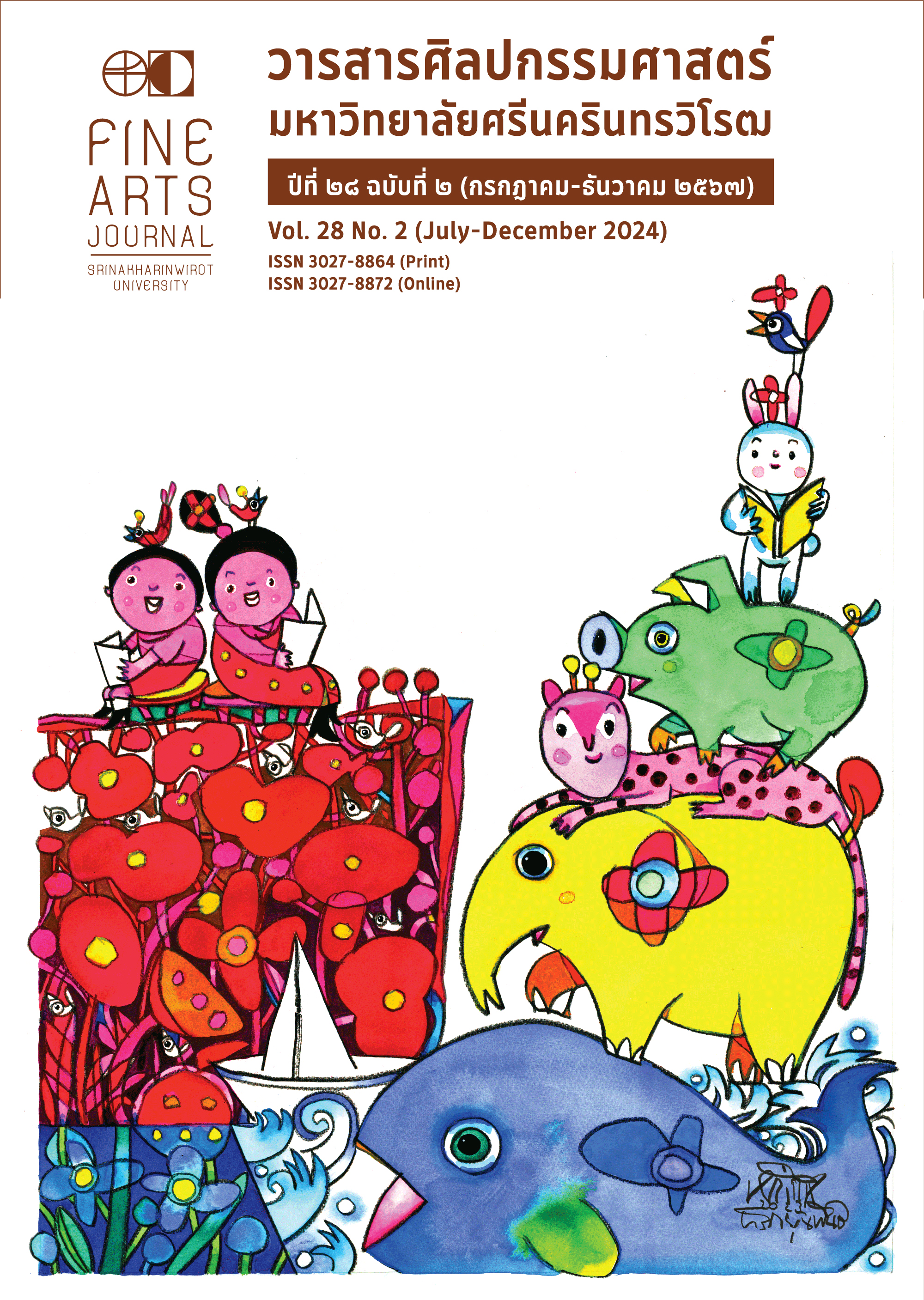สุนทรียภาพใหม่ศิลปะภาพวาดบนเครื่องเคลือบคณะศิลป์แปดสหายแห่งจูซานจิ่งเต๋อเจิ้น เพื่อการออกแบบผลิตภัณฑ์วัฒนธรรมสร้างสรรค์
คำสำคัญ:
เครื่องเคลือบจิ่งเต๋อเจิ้น, แปดสหายแห่งจูซาน, ผลิตภัณฑ์วัฒนธรรมสร้างสรรค์, สุนทรียภาพใหม่บทคัดย่อ
งานวิจัยนี้มีวัตถุประสงค์เพื่อศึกษาการเปลี่ยนแปลงรูปแบบทางศิลปะและปัจจัยที่มีอิทธิพลต่อภาพวาดบนเครื่องเคลือบของแปดสหายแห่งจูซาน วิเคราะห์รูปแบบ เทคนิค และสุนทรียภาพใหม่ของภาพวาดบนเครื่องเคลือบของแปดสหายแห่งจูซาน โดยใช้สุนทรียภาพ เทคโนโลยี และวิธีการการวาดภาพเครื่องเคลือบของแปดสหายแห่งจูซานในการออกแบบผลิตภัณฑ์วัฒนธรรมสร้างสรรค์ จากการศึกษาเอกสาร การลงภาคสนาม การสัมภาษณ์ผู้เชี่ยวชาญที่เกี่ยวข้อง ทำให้ทราบถึงคุณค่าทางสุนทรียภาพและประวัติศาสตร์ของศิลปะภาพวาดเครื่องเคลือบของแปดสหายแห่งจูซานทั้ง 10 ท่าน คือ Wang Qi, Wang Dafan, Xu Zhongnan, Deng Bishan, Wang Yeting, Cheng Yiting, Tian Hexian, Bi Botao, He Xuren และ Liu Yucen แยกแยะคุณค่าทางสุนทรียภาพและคุณค่าทางประวัติศาสตร์ของศิลปะการวาดภาพเครื่องเคลือบ ค้นหาจุดเชื่อมระหว่างสุนทรียภาพใหม่ของภาพวาดบนเครื่องเคลือบของแปดสหายแห่งจูซานกับแนวคิดการออกแบบผลิตภัณฑ์วัฒนธรรมสร้างสรรค์ ที่ได้จากการสัมภาษณ์ผู้เชี่ยวชาญและการสำรวจความเห็นผ่านแบบสอบถาม ผสมผสานความหลากหลาย ทันสมัย ใช้หลากหลายเทคนิค นำไปสู่การออกแบบชุดผลิตภัณฑ์วัฒนธรรมสร้างสรรค์จำนวน 5 ชุดที่นำรูปแบบของภาพวาดบนเครื่องเคลือบแปดสหายแห่งจูซานผสมผสานกับการใช้งานแบบร่วมสมัย สะท้อนแนวคิดสุนทรียภาพใหม่และสุนทรียภาพร่วมสมัย ซึ่งผลิตภัณฑ์บางส่วนใช้วิธีควบคุมแสงเงา ทั้งยังสามารถประกอบรวมกันหลายชิ้น ทำให้เกิดประสบการณ์ทางสุนทรียภาพที่หลากหลาย
Downloads
เอกสารอ้างอิง
Baidu. (2023, February 25). The eight friends of Zhushan. Retrieved May 10, 2023, from
https://baike.baidu.com/item/%E7%8F%A0%E5%B1%B1%E5%85%AB%E5%8F%8B/771532
Ding, L. (2021). On the artistic characteristics and aesthetic characteristics of Cheng Yiting's
works. Cultural Relics World, (1), 90-94.
Geng, B., & Qin, X. (2004). The eight friends of Zhushan (Vol. 1). Jiangxi, China: Jiangxi Fine Arts.
Han, S. (2016). Porcelain from the Jingdezhen Kiln of the Republic of China collected by the
Jiangxi Provincial Museum. Retrieved May 12, 2023, from https://www.fx361.com/page/2016/0803/645843.shtml
Li, H. (2015). Research on the aesthetics of porcelain painting by Wang Dafan, the "Eight
Friends of Zhushan" (Doctoral dissertation). Jingdezhen Ceramics Institute, Jingdezhen, China.
Liao, Y. (2014). On the inheritance and innovation of literati painting by the "Eight Friends of
Zhushan" porcelain painting art. Decoration, (6), 133-134.
Sohu. (2015, June 14). The "Eight Friends of Zhushan" porcelain painting art inherits and
innovates literati paintings. Retrieved May 10, 2023, from https://www.sohu.com/a/19083320_182042
Sohu. (2019, July 31). The boneless method of the three technique systems of Chinese
painting. Retrieved April 20, 2023, from https://www.sohu.com/a/330639667_99941818
Xiong, J., & Xiong, H. (2022). Analysis of the origin and process of Liu Yucen's water-dotted
peach blossom technique. Ceramic Science and Art, (6), 41-42.
Xu, Y. (2022). On the "Eight Friends of Zhushan" and ceramic art characteristics. Foshan Ceramics, (12), 155-157.
Zhang, X. (2016). The Eight Friends of Zhushan. Nanchang, China: Jiangxi Fine Arts.
Zhong, L. (2002). On the artistic achievements of the eight friends of Zhushan and the
aesthetic characteristics of their works. Chinese Ceramics, 38(4), 46-52. doi:10.16521/j.cnki.issn.1001-9642.2002.04.01
ดาวน์โหลด
เผยแพร่แล้ว
รูปแบบการอ้างอิง
ฉบับ
ประเภทบทความ
สัญญาอนุญาต

อนุญาตภายใต้เงื่อนไข Creative Commons Attribution-NonCommercial-NoDerivatives 4.0 International License.






